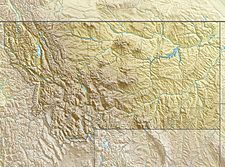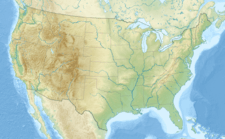Grasshopper Glacier (Montana) facts for kids
Quick facts for kids Grasshopper Glacier (Montana) |
|
|---|---|
| Type | Mountain glacier |
| Location | Park County, Montana, U.S. |
| Coordinates | 45°08′03″N 109°53′02″W / 45.13417°N 109.88389°W |
| Area | 320 acres (1.3 km2) |
| Length | .20 miles (0.32 km) |
| Terminus | Talus/proglacial lake |
| Status | Retreating |
Grasshopper Glacier is a unique glacier located in the Beartooth Mountains of Montana, U.S. It's part of the Custer National Forest and the Absaroka-Beartooth Wilderness. This area is also a big part of the Greater Yellowstone Ecosystem.
This glacier is famous for something unusual: it holds millions of grasshoppers frozen inside its ice! Some of these grasshoppers have been trapped for hundreds or even thousands of years. Many of them belong to species that are now extinct.
Contents
Grasshopper Glacier: A Frozen Mystery
Grasshopper Glacier is about .20 miles (0.32 km) long and .25 mi (0.40 km) wide. It starts high up, more than 11,300 feet (3,400 m) above sea level. When it was first studied in the early 1900s, it was much bigger, over 5 mi (8.0 km) long.
Today, the glacier is actually several smaller glaciers. Each one sits in a bowl-shaped hollow on the side of a mountain, called a cirque. These cirques face north, which helps keep the ice from melting too quickly.
Why So Many Grasshoppers?
The glacier got its name because of the huge number of grasshoppers found in its ice. Scientists believe that these grasshoppers, also known as locusts, were caught in severe storms. They might have been flying in massive swarms, sometimes with trillions of insects, when bad weather hit. The cold and snow would have trapped them, freezing them into the ice.
The ice has kept these ancient grasshoppers very well preserved. Early researchers were able to send samples to entomologists, who are scientists who study insects. These experts could identify the species. They even found some of the extinct Melanoplus spretus, also known as the Rocky Mountain locust. This type of locust was known to exist until the early 1900s.
What's Happening to the Glacier?
For a long time, it was easy to find grasshopper remains in the glacier. However, things have changed since the late 1980s. There has been less snowfall and higher temperatures. This means the glacier is melting faster.
As the ice melts, the frozen grasshoppers are exposed. But they often decompose (break down) before anyone can collect them. This melting shows how climate change is affecting even remote places like Grasshopper Glacier.
Visiting the Glacier
Getting to Grasshopper Glacier is quite challenging. The weather conditions can be very harsh. You usually need to travel by an off-road vehicle for a while. After that, it's a hike of several miles to reach the base of the glacier.
The main road nearby, the Beartooth Highway (U.S. 212), is often closed for up to 10 months of the year due to snow. This makes access even harder.
There are also two other smaller glaciers nearby that have the same type of grasshoppers frozen in them. One is also called Grasshopper Glacier, and the other is simply named Hopper Glacier. Other glaciers in different areas, like the Crazy Mountains and Grasshopper Glacier in the Shoshone National Forest in Wyoming, are also named for the same reason.



